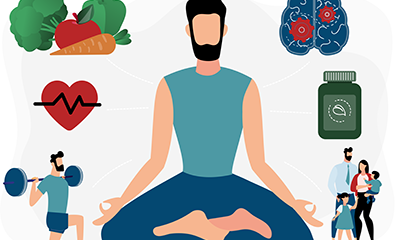HEALTH
Why the stories we tell are important for health

“Our lives are ceaselessly intertwined with narrative, with the stories we tell and hear told, those we dream or imagine or would like to tell, all of which are reworked in the story of our own lives that we narrate to ourselves” (White & Epston, 1990).
Throughout time, people have told stories. Perhaps from the beginning of language—the original “once upon a time”—storytelling has been a way of passing down knowledge and information. Stories tell us who we are, how the world works, and what values we should live by. They tell us what is possible, what is not, and what, if anything, may lay beyond the ordinary world of our senses.
Telling and listening to stories is wired into our psyches and nervous systems. Although stories have, at times, been used to exclude and harm, when used in a therapeutic context they have the power to heal and transform. A good story can foster connection and insight, convey healing or empowering metaphors, and activate a client’s resilience, imagination, and creativity. When a story strikes the right chord, it can shift a client’s perspective and open new ways of thinking and seeing.
It’s no wonder that the ancient art of storytelling has been incorporated into everything from violence prevention and trauma reduction programs to medical care and psychotherapy (Zerla, 2017; Hammel, 2018). Dan Yashinsky, a professional storyteller, has used his craft in medical settings and found that “for people with dementia, storytelling sparks rich and imaginative responses, even from those who have forgotten the names of their loved ones. For psychiatry patients, being treated for severe depression, wonder tales full of breathtaking suspense can help them regain their desire to discover what happens next—in the story, and in their own lives. In the palliative unit, we listen to life stories, share tales of wisdom from around the world, and we laugh, too, despite the solemn setting” (Yashinsky, 2017).
When social workers think about storytelling in the context of counseling, many think about the stories clients bring—conscious and unconscious—about their history, relationships, and struggles. Or they may think about how, during the course of therapeutic exploration and processing, new narratives that better support a client’s hopes and psychological growth are created.
But in some cases, counseling professionals are the ones doing the storytelling. Whether sharing tales of the Trojan War with combat veterans (Shay, 2003), reading children’s stories intended to foster psychological growth in terminally ill patients (Grey, 1998), or using fairy tales to enhance a sense of meaning and purpose (Bettelheim, 2010), or telling “healing stories” aimed at altering self-limiting beliefs and reactive patterns (Burns, 2001), social workers can use this timeworn craft to strengthen the therapeutic bond and catalyze change.
Benefits
The potential benefits of incorporating storytelling into the therapeutic encounter are numerous and include the following:
• Stories often contain profound wisdom as well as metaphorical and archetypal truths that can be conveyed in familiar images and simple language.
• Stories help us see and assimilate things about our life and circumstances from a comfortable distance, at a safe pace, in a context of safety and support.
• A story can create warmth and connection between the one telling the story and the one listening, enhancing the therapeutic alliance.
• For those feeling stuck or with little energy as they struggle with depression, illness, or overwhelming stress, hearing a story can be a pleasant respite during which they can simply relax and listen.
• Stories can engage our sense of humor, uncover strengths and novel solutions, and normalize experiences in ways that reduce feelings of shame or isolation. They can enhance our perspective, loosen the weight of troubling thoughts and emotions, evoke positive memories, and inspire hope.
• Stories can be multidimensional and multisensory, honing in on not just what a character did but also what they thought and felt, what was happening inside their bodies, and what they intended by their behavior vs. how those behaviors were interpreted by others.
• Many stories contain a therapeutically useful archetype that Joseph Campbell (1988) called the “hero’s journey” in which a person is compelled or pushed, often by some kind of crisis, onto a difficult journey during which trials and doubts are faced, and perspective and wisdom acquired.
• Reflecting on the ways Milton Erickson, MD, used stories in psychotherapy, Rosen (1991) points out that counseling professionals can choose stories that contain specific “therapeutic suggestions” that engage a client’s unconscious mind to create new expectations and visions of what is possible.
Incorporating Into Practice
For social workers interested in adding this dimension to their practice, stories can be drawn from virtually anywhere. Legends, myths, sacred texts, and world literary
pink
Rose was extremely independent. For months, she struggled with the progression of respiratory illnesses, refusing anyone to help her. When she became unsteady on her feet, she finally allowed her daughter to move in and help with the care.
To her surprise, Rose found that giving up household chores and responsibilities associated with her illness freed up more time and energy for her family and friends. She began to appreciate little things that previously went unnoticed, like the sound of birds emitted in the early morning and the way the love she felt for her newborn grandson gave her a tingling feeling in her stomach.
On one visit, she reflected on the paradox of how her body had become weak and unreliable, but her spirit, her inner self, was growing stronger and more sensitive to what was important.
She searched in vain for words to describe this paradox. On her wall was a picture of the great civil rights leader, Martin Luther King Jr. I thought of an anecdote from the bus boycott in Montgomery, AL in the 1950s, in which African-American citizens protested the racial segregation of public transportation. refused to take the city bus. I was wondering if a story would help Rose.
I told her about an older woman tired from months of walking instead of taking the bus. Fatigue crept into his hunched body and idling. At a community meeting after a long day, Martin Luther King Jr. spoke to her. Recognizing her commitment to the cause, he told her that there would be no disapproval if she returned to taking the buses. When she told him she would keep walking, he asked if she was tired. She replied, “My feet are tired, but my soul is rested.”
Rose smiled, repeating the phrase as if she had a holy power. We talked about how tired the woman was and how hard it must have been. But under exhaustion, she lurked a core of strength and peace. The story highlighted some of the truths emerging from Rose’s experience: her life had innate value regardless of her ability to maintain her roles and physical function, and inner strength was more substantial than physical strength.
In the weeks that followed, as Rose was confined to bed and struggling to cope with the loss of privacy and independence, she would frequently repeat the phrase during my visits: “My feet are tired, but my soul is rested.” She became an access point to connect with her deeper self and reinforce the fact that even though her body was getting weaker, her inner self was getting wiser, stronger.
Experience storytelling
In a sense, counseling and psychotherapy can be seen as a sophisticated type of storytelling in which clients’ stories are evoked, shared, heard, explored, and transformed. While social workers approach clients and patients using a variety of explanation and intervention models, we all carry stories and some of them can be helpful depending on the client.
While there is much to be said for how to choose, craft, time, and deliver a story in the context of consulting, for those interested in experiencing storytelling, Lankton, and Lankton (1989) suggest using stories and anecdotes with therapeutic metaphors that derive from of the social worker’s experience, knowledge, and interests: “Stories that derive from the therapist’s authentic experiences and understandings are believable and, when relevant to the client’s desired learning, are also fascinating, interesting, and engaging.”
Recognizing the need to protect confidentiality and professional boundaries, they suggest considering a client’s goals and clinical presentation and asking, “How is this going in my experience?” The people and images that come to mind in response to this question become the raw material from which a therapeutic metaphor can be constructed.
– Scott Janssen, MSW, LCSW, is a hospice social worker in Durham, North Carolina, and a member of the Trauma Informed Care Task Force of the National Hospice and Palliative Care Organization. Some of the material in this article was adapted from his book Standing at Lemhi Pass: Archetypal Stories for the End of Life and Other Challenging Times.
HEALTH
Understanding Pulsamento | A Rhythmic Journey to Wellness

Introduction to Pulsamento
pulsamento, In a world filled with constant motion and noise, finding moments of stillness and rhythm can be transformative. One such concept gaining attention is it, a rhythmic phenomenon that extends beyond its musical roots to influence various aspects of our lives. This article explores the essence of it, delving into its origins, scientific underpinnings, applications, and practical implications.
Understanding the Concept of Pulsamento
What is Pulsamento?
Pulsamento, derived from the Spanish word “pulsar” meaning to pulse or throb, refers to the rhythmic pulsation or heartbeat inherent in various phenomena. While commonly associated with music, it encompasses a broader spectrum, including biological rhythms, psychological patterns, and cultural expressions.
Origins and Background
The roots of pulsamento can be traced back to ancient civilizations where rhythmic rituals were central to communal activities. From tribal drum circles to synchronized chants, humans have long recognized the power of rhythm to unite, heal, and transcend.
The Science Behind Pulsamento
Biological Significance
At its core, pulsamento mirrors the innate rhythms of life, from the steady cadence of our heartbeat to the cyclic patterns of breathing and sleep. These biological rhythms not only regulate bodily functions but also influence our cognitive processes and emotional well-being.
Psychological Impacts
Studies have shown that exposure to rhythmic stimuli can modulate brain activity, leading to enhanced focus, relaxation, and emotional regulation. Whether through music, dance, or repetitive movements, it engages our senses and fosters a sense of coherence and connection.
Applications of Pulsamento
Health and Wellness
In the realm of health and wellness, pulsamento serves as a therapeutic tool for stress reduction, pain management, and rehabilitation. Techniques such as rhythmic breathing, drumming therapy, and mindfulness practices harness the power of this to promote holistic healing and resilience.
Music and Arts
In music and the arts, it transcends mere tempo and rhythm, shaping the expressive nuances of performance and composition. From the pulsating basslines of electronic music to the rhythmic brushstrokes of abstract painting, artists utilize this to evoke emotion, create tension, and convey meaning.
Technology
Innovations in technology have expanded the boundaries of this, with interactive devices and digital platforms offering new avenues for rhythmic exploration and expression. From wearable gadgets that sync with our heartbeat to immersive experiences that synchronize with ambient rhythms, technology enables us to engage with it in novel ways.
Pulsamento in Everyday Life
Enhancing Productivity
In the realm of productivity and efficiency, pulsamento serves as a catalyst for flow states and peak performance. By aligning tasks with natural rhythms and incorporating rhythmic breaks, individuals can optimize their workflow and sustain focus throughout the day.
Improving Creativity
In the creative process, its fuels inspiration and innovation, providing a rhythmic framework for exploration and experimentation. Whether through improvisational jam sessions or structured exercises, creatives leverage this to unlock new insights, patterns, and possibilities.
Stress Relief
Amidst the hustle and bustle of modern life, it offers a sanctuary of stillness and serenity. Mindful practices such as rhythmic breathing, meditation, and body percussion provide a rhythmic refuge, helping individuals unwind, recharge, and restore balance.
How to Incorporate Pulsamento into Your Life
Mindfulness Practices
Integrating pulsamento into mindfulness practices can deepen awareness, cultivate presence, and enhance overall well-being. Whether through rhythmic breathing exercises, walking meditations, or body scans, individuals can attune to the rhythmic cadence of their inner world and external environment.
Breathing Techniques
Rhythmic breathing techniques such as box breathing, coherent breathing, and resonance breathing synchronize inhalations and exhalations with natural rhythms, promoting relaxation, focus, and emotional equilibrium. By harnessing the power of this, individuals can regulate their autonomic nervous system and alleviate stress-related symptoms.
Creative Expression
Engaging in rhythmic activities such as drumming, dancing, or chanting unlocks the expressive potential of this, fostering spontaneity, connection, and joy. Whether solo or in community settings, creative practices grounded in pulsamento foster a sense of empowerment, belonging, and liberation.
Pulsamento in Cultural Context
Historical Significance
Throughout history, pulsamento has played a pivotal role in cultural rituals, ceremonies, and celebrations. From indigenous traditions to religious observances, rhythmic expressions have served as conduits for spiritual communion, communal bonding, and ancestral reverence.
Modern Interpretations
In contemporary culture, pulsamento continues to evolve and adapt, manifesting in diverse forms and contexts. From global music festivals to virtual dance parties, rhythmic experiences unite individuals across borders, languages, and identities, fostering solidarity, empathy, and collective consciousness.
Challenges and Misconceptions
Overcoming Obstacles
Despite its myriad benefits, incorporating this into daily life may pose challenges for some individuals. Whether due to hectic schedules, cultural barriers, or personal preferences, navigating obstacles requires patience, creativity, and adaptability.
Debunking Myths
Misconceptions surrounding this, such as its exclusivity to musicians or its irrelevance to non-western cultures, hinder its widespread adoption and appreciation. By debunking myths and demystifying its principles, we can promote inclusivity, accessibility, and cultural exchange.
Future Prospects of Pulsamento
Research and Development
As interest in pulsamento continues to grow, interdisciplinary research and innovation hold promise for advancing our understanding and application of rhythmic phenomena. From neuroscientific studies to technological advancements, ongoing exploration of this opens new avenues for healing, learning, and creativity.
Potential Innovations
Emerging technologies such as biofeedback devices, virtual reality experiences, and artificial intelligence algorithms offer exciting possibilities for expanding the scope and impact of this. By harnessing the power of data analytics, immersive simulations, and personalized interventions, future innovations have the potential to revolutionize how we engage with rhythm and wellness.
Conclusion
In conclusion, pulsamento offers a rhythmic journey to wellness, weaving together ancient traditions, scientific insights, and modern applications. Whether as a source of inspiration, a tool for transformation, or a beacon of connection, it invites us to tune into the rhythm of life and dance to the beat of our hearts.
Frequently asked questions
What distinguishes Pulsament from other types of rhythm?
Pulsamento emphasizes the recurrence of various impulses or vibrations and distinguishes it from continuous or irregular rhythms.
How is pulse used in Track Remedy?
Music therapists use the pulse to develop therapeutic interventions that promote calm, reduce tension, and increase emotional well-being.
What challenges are associated with the introduction of predominantly tap-based technologies?
Challenges include mitigating errors caused by resonance, ensuring synchronization in multiaspect systems, and managing inter-individual variability in healing responses.
Are there cultural versions within the interpretation of the Pulsament?
Yes, unique cultures interpret and use pulsation with specific methods, reflecting different perspectives on rhythm and resonance.
What function does the pulse play in the field of biomechanics?
In biomechanics, Pulsament is used to observe human movement patterns, muscle activation sequences and gait assessment and provides information on motor control and coordination.
HEALTH
Unveiling the Wonders of Acetatas | A Comprehensive Exploration

 In the wide range of chemical compounds, Acetatas stand out as fascinating and vital components with a wide range of possible applications. Our goal is to unravel the mysteries surrounding acetates and provide a comprehensive guide that not only educates, but eclipses existing content on the subject.
In the wide range of chemical compounds, Acetatas stand out as fascinating and vital components with a wide range of possible applications. Our goal is to unravel the mysteries surrounding acetates and provide a comprehensive guide that not only educates, but eclipses existing content on the subject.
Deciphering the intricacies of this is like unraveling a captivating puzzle. In this guide, we embark on a journey to explore the depths of acetates and illuminate their meaning, applications and implications. Join us in discovering the secrets and secrets behind acetates and leave no stone unturned in our search for knowledge.
1. What is Acetatas : everything you need to know
In the field of chemical compounds, Acetatas play a fundamental role and have a wide range of applications and implications. Essentially, acetates refer to a group of compounds characterized by the presence of the acetate ion. These compounds span a wide range, from pharmaceuticals to industrial solvents, each with their unique properties and uses.
Interesting paragraph:
At its core, Acetatas embodies versatility and utility and serves as a cornerstone in various industries. From their role in pharmaceutical formulations to their applications in chemical synthesis, acetates exhibit remarkable adaptability, making them indispensable components in numerous processes and products. Understanding the complexities of acetates reveals a world of opportunity where innovation and ingenuity come together to drive progress and prosperity.
2. Clarification of the origins of Acetatas
To truly understand the importance of Acetatas , it is important to trace their origins and evolution over time. Acetates date back to the beginning of chemical research and fascinate scientists and researchers with their unique properties and potential applications. From the groundbreaking experiments of renowned chemists to modern advances in synthesis and analysis, Ace-Tata’s journey is intertwined with the rich wealth of scientific discoveries.
Understanding Acetatas
What is this?
Acetates are esters or salts of acetic acid that are known for their versatility in various industries. These compounds have a remarkable range of applications, from the pharmaceutical industry to the food and beverage sector to the synthesis of polymers.
The role of Acetatas in industry
Pharmaceutical products
In the pharmaceutical world, Ace Tatas play a fundamental role as pharmaceutical middlemen. Due to their unique chemical properties, they are essential for the production of medicines and ensure effectiveness and stability.
Food and Drink
The food and beverage industry harnesses the power of acetate as a flavor enhancer and preservative. Dive into our exploration and discover how these compounds contribute to the tempting taste and longevity of your favorite consumer products.
Polymer synthesis
Polymer synthesis, a fundamental process in various manufacturing areas, benefits significantly from the incorporation of acetates. Their compatibility and reactivity make them invaluable for producing durable and versatile materials.
Types of Acetatas
Ethyl acetate
Among the large number of Acetatas , ethyl acetate stands out as a widely used variant. This section looks at its properties, applications and why it has become a cornerstone in numerous industries.
Properties
Ethyl acetate has a pleasant fruity aroma that distinguishes it from its chemical counterparts. Its low toxicity and high solubility in common solvents contribute to its widespread use.
Applications
From nail polish remover to medicine, the possible uses of ethyl acetate are diverse. Discover the countless ways this connection improves our daily lives.
The art of surpassing rank
Preparation of high-quality content
In the digital age, the battle for online visibility is fierce. To outperform existing articles on Acetatas , our approach goes beyond keyword density and encompasses the art of creating content that not only informs but also captivates.
Keyword integration
Strategically placing keywords related to Acetatas ensures that search engines see the relevance of our content. By seamlessly integrating these keywords into our narrative, we create authority and improve visibility.
Immerse yourself in the applications of Acetatas
State-of-the-art innovations
As the industry evolves, so do the applications of Acetatas . Discover breakthrough innovations that harness the potential of these compounds and pave the way for a future in which Acetatas plays an even more important role.
Case studies
Real-world examples show the impact of Acetatas in various sectors. Our in-depth case studies provide concrete evidence of the importance and effectiveness of these compounds, providing readers with valuable insight.
Frequently asked questions
What are the main applications of acetates in the pharmaceutical industry?
Acetates are typically used in pharmaceutical formulations to improve drug solubility and bioavailability, resulting in more effective treatments for various clinical diseases.
Are acetates harmful to the environment?
While some acetates may also have an impact on the environment, efforts are being made to develop biodegradable options that minimize ecological impact, thereby promoting sustainability and responsible use.
Can acetates be incorporated into the customer’s usual products?
Yes, acetates are found in numerous consumer products, including perfumes, cosmetics, paints and adhesives, where they contribute to scent, texture and functionality.
How are acetates synthesized in business approaches?
Acetates are generally synthesized through esterification reactions in which acetic acid reacts with alcohol in the presence of a catalyst to form the preferred ester compound.
Are there safety concerns associated with handling acetates?
As with any chemical compound, proper handling and storage procedures are important to ensure safety when handling acetates. It is important to follow recommended guidelines and precautions to limit risks.
What role do acetates play in the food business?
Acetates are used as flavor enhancers and perfume components in foods, contributing to the overall sensory pleasure and palatability of various culinary creations.
Conclusion
In Conclusion, our exploration of Acetatas has gone beyond the ordinary. We uncover the complexity of its properties, delve into its cross-industry applications, and demonstrate the strategic approach to surpass existing content.
HEALTH
Senisieta: Unlocking Nature’s Wellness Secret

Welcome to the world of Senisieta, a natural wonder that has been revered for centuries for its remarkable health and beauty benefits. In this article, we will delve deep into the origins, benefits, uses, and safety considerations of it, uncovering its secrets and shedding light on its potential to enhance your well-being.
Benefits of Senisieta
Health Benefits
Senisieta is celebrated for its myriad of health benefits, ranging from immune system support to stress relief and anti-inflammatory properties. Incorporating this into your daily routine can promote overall wellness and vitality.
Beauty Benefits
Beyond its health benefits, Senisieta is also prized for its remarkable effects on beauty and skincare. From nourishing the skin to promoting healthy hair, it offers a natural solution for enhancing your physical appearance.
History and Origins of Senisieta
Senisieta traces its roots back to ancient civilizations, where it was revered as a sacred plant with powerful healing properties. Indigenous cultures across the globe have long utilized this for its medicinal and therapeutic benefits, passing down traditional remedies through generations.
How Senisieta Works on Health
Immune System Boost
One of the key benefits of Senisieta is its ability to boost the immune system, helping the body defend against infections and illnesses. By strengthening the body’s natural defenses, it can enhance resilience and promote overall health.
Stress Relief
In today’s fast-paced world, stress has become a ubiquitous presence in our lives. Senisieta offers a natural remedy for stress relief, helping to calm the mind and promote relaxation. Incorporating this into your daily routine can help you find balance and peace amidst life’s challenges.
Anti-inflammatory Properties
Chronic inflammation is linked to a host of health issues, including heart disease, arthritis, and autoimmune disorders. Senisieta possesses powerful anti-inflammatory properties, which can help reduce inflammation and alleviate symptoms associated with inflammatory conditions.
Senisieta in Beauty and Skincare
Skin Nourishment
Senisieta is a potent source of vitamins, minerals, and antioxidants that nourish and rejuvenate the skin. Whether applied topically or ingested internally, it can help improve skin texture, promote collagen production, and combat signs of aging.
Hair Care
For centuries, Senisieta has been prized for its ability to promote healthy hair growth and prevent hair loss. Rich in essential fatty acids and nutrients, it nourishes the scalp, strengthens hair follicles, and enhances hair vitality.
Different Forms of Senisieta
Senisieta is available in various forms, including oil, capsules, and tea, each offering unique benefits and applications. Whether you prefer topical application or internal consumption, this product suited to your needs.
How to Use Senisieta
Topical Application
For skincare and hair care purposes, Senisieta oil can be applied directly to the skin or scalp, providing nourishment and hydration. Massage a few drops of its oil onto clean skin or add it to your favorite skincare products for added benefits.
Internal Consumption
To reap the health benefits of Senisieta, consider incorporating it into your daily diet. This capsules or tea offer a convenient way to enjoy its medicinal properties, whether you’re looking to boost your immune system or alleviate inflammation.
Senisieta Safety and Side Effects
While Senisieta is generally safe for most people, it’s essential to be aware of potential allergic reactions and interactions with medications. If you have known allergies or are taking medication, consult with a healthcare professional before using it.
Potential Allergic Reactions
Some individuals may experience allergic reactions to Senisieta, particularly if they have allergies to related plants such as ragweed or marigolds. If you develop symptoms such as itching, swelling, or difficulty breathing after using this, discontinue use and seek medical attention.
Interaction with Medications
Senisieta may interact with certain medications, including blood thinners and diabetes medications. If you’re taking prescription medication, speak with your doctor before incorporating this into your regimen to avoid potential complications.
Senisieta in Traditional Medicine
Cultural Significance
In many indigenous cultures, Senisieta holds significant cultural and spiritual importance, often being used in traditional healing ceremonies and rituals. Its healing properties are deeply intertwined with cultural beliefs and practices, reflecting a holistic approach to health and wellness.
Traditional Remedies
Traditional healers have long relied on Senisieta to treat a wide range of ailments, from respiratory infections to digestive issues. By harnessing the power of nature, traditional remedies offer gentle yet effective solutions for promoting health and healing.
Senisieta in Modern Science
In recent years, scientific research has begun to uncover the mechanisms behind it’s healing properties, shedding light on its potential therapeutic applications. Clinical studies have demonstrated its effectiveness in supporting immune function, reducing inflammation, and promoting overall well-being.
Buying and Storing Senisieta
When purchasing its products, it’s essential to choose reputable brands that prioritize quality and purity. Look for organic certifications and third-party testing to ensure that you’re getting a high-quality product free from contaminants.
Proper storage is also key to preserving the potency of this. Store its oil in a cool, dark place away from direct sunlight, and tightly seal capsules or tea bags to prevent oxidation and degradation.
Future Trends and Developments
As interest in natural remedies continues to grow, we can expect to see an increase in the popularity and availability of Senisieta products. From innovative formulations to expanded research initiatives, the future of this looks promising in the quest for optimal health and wellness.
Myths and Misconceptions
Despite its long history of use and numerous scientific studies supporting its benefits, it is not without its myths and misconceptions. From exaggerated claims to misinformation, separating fact from fiction is essential for making informed decisions about it’s use.
Conclusion
In conclusion, Senisieta stands as a testament to the power of nature in promoting health and beauty. From its ancient origins to its modern-day applications, it offers a holistic approach to wellness that resonates with both tradition and science. By incorporating this into your daily routine, you can unlock the secrets of this natural wonder and embark on a journey to enhanced well-being.
Unique FAQs
1.What makes it different from other spiritual practices?
2.How can beginners integrate this into their everyday lives?
3.Is it compatible with different religious beliefs?
4.What scientific evidence supports the benefits of it?
5. How do I find authentic its teachers and resources?
-

 HEALTH2 years ago
HEALTH2 years agoDr. Naval Parikh: Thyroid Disease Signs, Symptoms & Treatment Options
-

 HEALTH2 years ago
HEALTH2 years agoDr. Naval Parikh: Back Injuries, Types, Causes, Symptoms and Treatment
-

 FASHION12 months ago
FASHION12 months agoBest Color Shoes for Men: Making a Style Statement
-

 TECH2 years ago
TECH2 years agoHow to Turn Flashlight On iPhone & Off, 3 Easy Ways
-

 Celebrity2 years ago
Celebrity2 years agoDay 3 of Spring 2016 New York Fashion Week’s most inspiring
-

 GAMES2 years ago
GAMES2 years agoAbout Tekken 3
-

 APPS2 years ago
APPS2 years agoY2mate download videos from YouTube Facebook etc
-

 HEALTH8 months ago
HEALTH8 months agoTop 5 Best Activities For Well being
